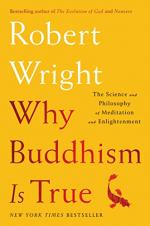
|
| Name: _________________________ | Period: ___________________ |
This test consists of 15 multiple choice questions and 5 short answer questions.
Multiple Choice Questions
1. An intertemporal utility function represents how willing a person is to delay what?
(a) Death.
(b) Injury.
(c) Gratification.
(d) Understanding.
2. The author states that the idea of enlightenment is to take what action in regard to one's delusions?
(a) To obscure them.
(b) To lose them.
(c) To remember them.
(d) To define them.
3. Which of the three schools of meditation supports the idea that a critical distance of separation between the self and individual thoughts will give the conscious self more control?
(a) Tibetan.
(b) Vipassana.
(c) Western.
(d) Zen.
4. The author states, “It’s kind of amazing, when you think about it, that the world would be set up this way: that the path you embark on to relieve yourself of suffering would, if pursued assiduously, lead you to become not just a happier person but a person with a clearer view of" (263) what two types of reality?
(a) Metaphysical and spiritual.
(b) Metaphysical and moral.
(c) Moral and ethical.
(d) Universal and accepted.
5. The author states that "modules seem to have the ability to recruit" (130) what on behalf of their goals?
(a) Faith.
(b) Other modules.
(c) Tenets of belief.
(d) Reasons.
6. What is the term for the tendency to attribute inner essences to things?
(a) Essentialism.
(b) Deconstructionism.
(c) Realism.
(d) Surrealism.
7. When it feels like the rational self makes a decision, what is really happening, according to Kurzban?
(a) It is actually that the sense of self is ebbing away.
(b) It is actually that the not-self is becoming fully realized.
(c) It is actually that one mental compartment is larger than another.
(d) It is actually that one module is stronger than another in a particular situation.
8. The author states that he suspects that what word is dependent upon "a melange of feelings that you've come to associate with" this object?
(a) Ocean.
(b) Cloud.
(c) Biscuit.
(d) Butterfly.
9. With what system is the dorsolateral prefrontal cortex associated?
(a) The endocrine system.
(b) The adrenal system.
(c) The prefrontal cortex system.
(d) The dopamine system.
10. The author compares self-discipline to what part of the human body?
(a) A blood vessel.
(b) A bone.
(c) A muscle.
(d) A heart.
11. The author states that rather than seeing the world as hopeless and empty, enlightened and otherwise accomplished meditators see each individual object, person, and experience as empty in the sense that it does not have a preset what?
(a) Truth.
(b) Worth.
(c) Connotation.
(d) Value.
12. What type of plant does the author now recognize as beautiful after his meditation retreat?
(a) Raspberries.
(b) Dandelions.
(c) Daisies.
(d) Plantains.
13. The dorsolateral prefrontal cortex is described as the seat of what?
(a) Abstract reasoning.
(b) The ego.
(c) Emotions.
(d) Paranoia.
14. What does the lizard represent at the meditation retreat attended by the author?
(a) Loving kindness.
(b) Awareness.
(c) Oneness.
(d) Belief.
15. The author states that what element only acts as a proxy between various feelings?
(a) Reason.
(b) Synapses.
(c) Sight.
(d) Intuition.
Short Answer Questions
1. What problem does the author say afflicts him when he is trying to work?
2. Which philosopher is said to have had ideas that clearly reflect Buddhist ideals and that are reflected in modern psychology studies?
3. The author states that seeing the world as what is an essential step on the path to enlightenment?
4. The author states that neither kind of module in the chocolate anecdote was more what than another?
5. What is Robert Zajonc's field of expertise?
|
This section contains 549 words (approx. 2 pages at 300 words per page) |

|




